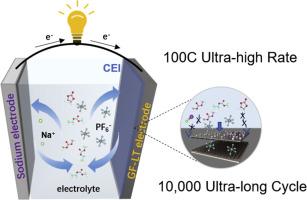由 Li2TiO3 改性阴极-电解质-间相实现的超高速率和长循环寿命钠基双离子电池
IF 18.9
1区 材料科学
Q1 CHEMISTRY, PHYSICAL
引用次数: 0
摘要
钠基双离子电池(SDIB)因其高电压、低成本、安全性和环保性而受到广泛关注。然而,不规则的球形石墨阴极受限于传质不均匀性和反应动力学迟缓,这是由于阴离子在高度曲折的路径和感应各向异性电场中迁移不均匀造成的。在此,我们报告了一种简便的溶解-沉淀-碳化优化改性策略,用于合成一系列纳米锂2TiO3/C改性鳞片石墨(GF-LTx,x=1、2.5和5)作为 SDIB 的阴极。通过原位反应形成的 Li2TiO3-C-Cathode Electrolyte Interphase(Li2TiO3-C-CEI)三位一体层具有良好的循环性能。通过 DFT 分子轨道理论和分布弛豫时间(DRT)分析,进一步探讨了 Li2TiO3-C-CEI 的内在机理。值得注意的是,GF-LT2.5 在 3-5.2 V(对 Na/Na+)电压下实现了 10,000 次稳定循环,初始容量为 91.1 mAh g-1,每次循环的衰减率仅为 0.00217%。此外,GF-LT2.5 还具有 100C 的超高速性能,单次充电时间仅为 30 秒,低电流密度下的容量为 86%。红外热成像证实了凝胶基柔性袋式电池良好的热稳定性和安全性。这项工作为设计高速率性能、长周期稳定性和高安全性的储能系统提供了新的见解。本文章由计算机程序翻译,如有差异,请以英文原文为准。


Ultra-high rate and long cycle life sodium-based dual-ion batteries enabled by Li2TiO3-modified cathode-electrolyte-interphase
Sodium-based dual-ion batteries (SDIBs) have received widespread attention due to their high voltage, low cost, safety, and eco-friendliness. Nevertheless, the irregular spherical graphite cathodes are limited by the mass transfer non-uniformity and sluggish reaction kinetics due to uneven anion migration through the highly tortuous pathways and the inductive anisotropic electric fields. Herein, we report a facile dissolution-precipitation-carbonation optimized modification strategy to synthesize a series of nano-Li2TiO3/C-modified graphite flake (GF-LTx, x = 1, 2.5, and 5) as cathode for SDIBs. The Li2TiO3-C-Cathode Electrolyte Interphase (Li2TiO3-C-CEI) trinity layer by in situ reactions shows good cycling performance. The intrinsic mechanism of Li2TiO3-C-CEI was further explored by DFT molecular orbital theory and distribution relaxation time (DRT) analysis. Notably, the GF-LT2.5 achieves 10,000 stable cycles at 3–5.2 V (vs. Na/Na+) with a initial capacity of 91.1 mAh g−1 and a decay rate of only 0.00217 % per cycle. Furthermore, GF-LT2.5 demonstrates an ultra-high rate performance of 100C with only 30 s for a single charge and 86 % capacity for low current density. Infrared thermography confirms the good thermal stability and safety of the gel-based flexible pouch cells. This work provides new insights into the design of high-rate performance, long-cycle stability, and high-safety energy storage systems.
求助全文
通过发布文献求助,成功后即可免费获取论文全文。
去求助
来源期刊

Energy Storage Materials
Materials Science-General Materials Science
CiteScore
33.00
自引率
5.90%
发文量
652
审稿时长
27 days
期刊介绍:
Energy Storage Materials is a global interdisciplinary journal dedicated to sharing scientific and technological advancements in materials and devices for advanced energy storage and related energy conversion, such as in metal-O2 batteries. The journal features comprehensive research articles, including full papers and short communications, as well as authoritative feature articles and reviews by leading experts in the field.
Energy Storage Materials covers a wide range of topics, including the synthesis, fabrication, structure, properties, performance, and technological applications of energy storage materials. Additionally, the journal explores strategies, policies, and developments in the field of energy storage materials and devices for sustainable energy.
Published papers are selected based on their scientific and technological significance, their ability to provide valuable new knowledge, and their relevance to the international research community.
 求助内容:
求助内容: 应助结果提醒方式:
应助结果提醒方式:


